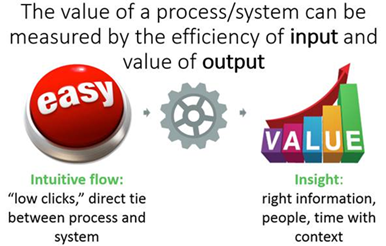In part one of this post, I identified several measurable usability metrics that we can adapt to the needs of our own organizations. By integrating organizational readiness with our PPM implementation lifecycle, we can architect the business outcomes that we need:

We can apply this concept at every point of process and system implementation or maturity, and we can improve our environments by following best practices like the ones I outline here. The crux of the matter is people doing processes that profit. Another way to look at this is with the goal of avoiding “garbage in, garbage out;” this post aims to share ways to attain real value-not just garbage masquerading as value.
At the highest level, any implementation/application management strategy must integrate organizational business objectives, IT business drivers and expected solution outcomes. An effective high-level design provides traceability between the requirements, the technology that supports them, and the architecture on which the technology will be deployed. The term “traceability metrics” applies to this upward and downward flow for all activities. Based on my experiences with implementing PPM solutions, here are some guiding principles:
1. Starting from the top down, business objectives drive purpose and requirements as the “why” to enable the solution. The “how” is tracked up when building the implementation.
 By defining business objectives for each current and new process and system function, even if it’s a high-level definition, we enable our work to tie directly to a value output. This means that every required action is defined and communicated from the perspective of outcomes. For example:
By defining business objectives for each current and new process and system function, even if it’s a high-level definition, we enable our work to tie directly to a value output. This means that every required action is defined and communicated from the perspective of outcomes. For example:
- Entering time enables specific business needs such as answering the questions “What are my people working on,” “How well are we planning,” and “Are my teams working on the highest-priority activities”
- Project status reporting standards allow for weekly risk mitigation and support from leadership
- Approval process (hard book) for team members supports the resource manager and project manager as they plan for allocations and staffing
2. Upon understanding the “why,” following the flow below supports the high-level system design:
- Define dashboard/report insight requirements and the process for consumption, cadence and audiences
- Define field-level data and logic requirements associated to reporting
- Define field-level input strategy and define process, cadence, audience for data entry
- Define audit and data quality KPIs
Initially, we often talk about reporting, but when implementing, we sometimes focus on data entry first. Once we have data, we finalize reporting. But remember: It is key to tie each data entry point directly to an insightful output, and reporting must be the driver of data entry.
3. When process and data entry requirements are established, the system must be streamlined and aligned to the actions that end users will execute. Examples specific to PPM are:
- Setting login home to primary role activity
- Giving Portlets, tabs and home menu items the same names as their associated processes
- Removing views of any unused functions, including reporting based on role
- Configuring Portlets with only the required data input
To facilitate operational efficiency and data quality, intuitiveness, simplicity and relating actions to the people taking them must be key goals of the deployment.
As PPM system and process practitioners, we need to constantly deliver solutions with people, not just users, in the middle of the entire implementation lifecycle. As an interesting sidebar, when I Google “people,” images of faces appear, and when I Google “users,” avatars and drones show up. In comparing these images, I feel:
- Empathy (for people) v. apathy (for those avatars and drones)
- Ideas, design and innovation (from people) v. just doing a job (avatars and drones)
- Comradery and teamwork (by people) v. assimilation (avatars and drones)

By focusing on these suggestions for helping people through adoption strategies, we can greatly improve the value of a solution for our organizations.
For readers interested in more detail, check out my Blog Series. I encourage you to participate in the best-in-class site, where we have access to our peers, events and support. You can also reach out to CA Services for individualized business outcome references and analysis. Feel free to post in the comments section of this blog or contact me directly via email and @PPMWarrior.